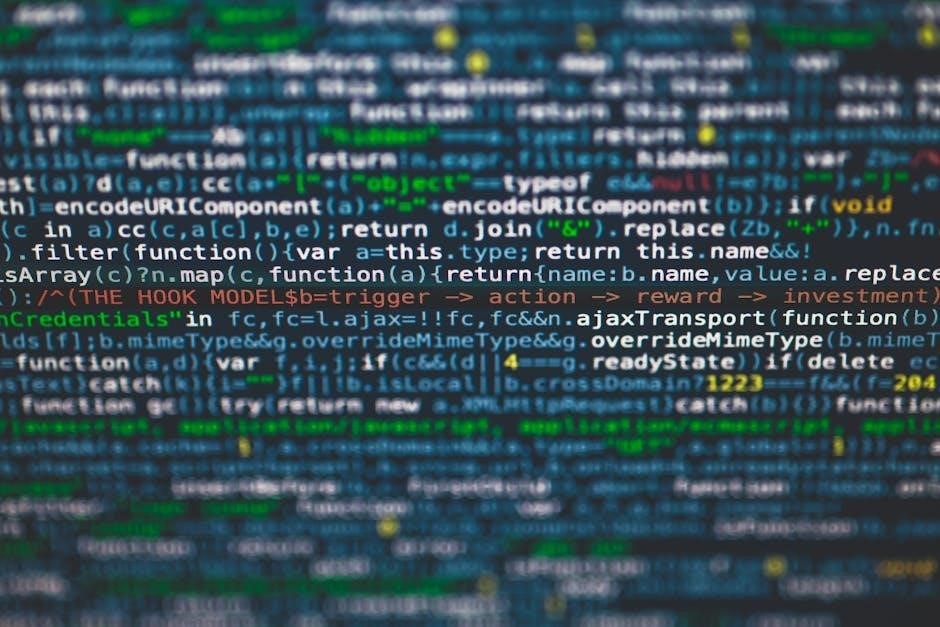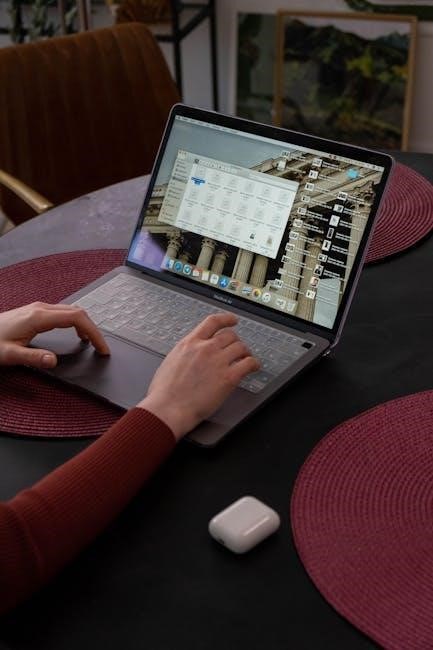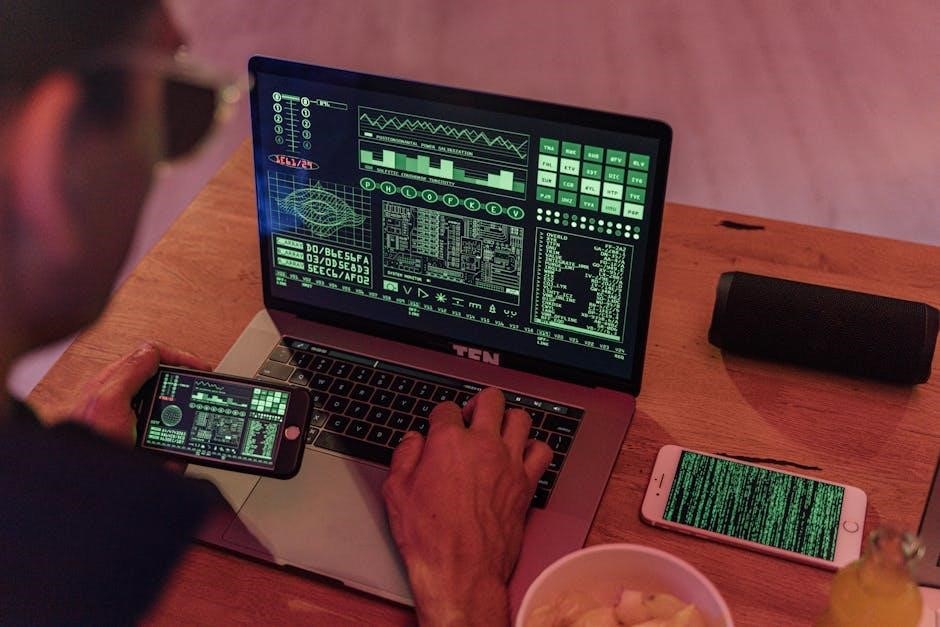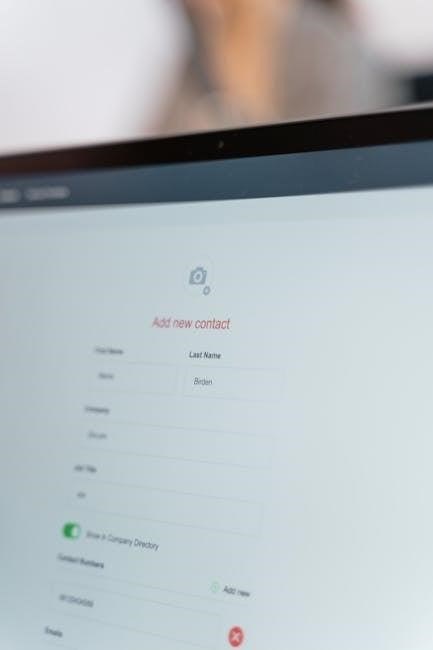first data fd130 user guide
The First Data FD130 is a reliable and versatile point-of-sale terminal designed for secure and efficient transactions. It supports card payments, cash transactions, and gift cards, ensuring seamless checkout experiences. Key features include VEnTA functionality, thermal printing, and optional device integration. This terminal is ideal for businesses seeking a robust solution for accepting payments and managing sales.
1.1 What is the First Data FD130?
The First Data FD130 is a compact, user-friendly point-of-sale terminal designed for seamless payment processing. It supports a variety of transaction types, including card and cash payments, making it ideal for small to medium-sized businesses. The terminal features a durable design, easy-to-use interface, and robust security measures to protect customer data. It is widely used in retail, hospitality, and service industries to streamline checkout processes and enhance customer satisfaction. With its intuitive setup and reliable performance, the FD130 ensures smooth integration into any business environment.
1.2 Key Features of the FD130 Terminal
The First Data FD130 terminal is a robust, user-friendly device designed for efficient payment processing. It supports multiple transaction types, including card, cash, and gift card payments, ensuring flexibility in checkout operations. The terminal features VEnTA functionality, allowing manual or card-based transaction authorization, and includes split tender options for mixed payment methods. Its secure design, thermal printing capabilities, and compatibility with optional devices enhance its versatility. With clear instructions and intuitive controls, the FD130 streamlines operations for a seamless payment experience.

Getting Started with First Data FD130
Begin by unpacking the FD130 terminal and reviewing the contents, including the terminal, thermal paper, and telephone cable. Follow the included instructions to set up the terminal and connect it to your network or telephone line. Use the Quick Reference Guide for step-by-step guidance on daily operations and essential functions.
2.1 Unboxing the Terminal
When you receive your First Data FD130 terminal, carefully remove it from the packaging. Inside the box, you will find the terminal, a roll of thermal paper, a telephone cable, and possibly an optional device, such as a card reader or PIN pad. Inspect all components for damage and ensure everything is accounted for
Before setting up, take a moment to become familiar with the terminal’s design and layout; This initial inspection ensures a smooth setup process and prepares you to begin using the terminal effectively.
2.2 Quick Reference Guide Overview
The Quick Reference Guide is an essential companion for operating the First Data FD130 terminal. It provides straightforward, step-by-step instructions for performing daily tasks and troubleshooting common issues. The guide is organized in a user-friendly manner, making it easy to navigate even for those new to the terminal.
Familiarize yourself with the essential functions and operations listed in the guide, such as processing transactions, activating features, and maintaining the terminal. This resource ensures you can confidently perform daily tasks and maximize the terminal’s capabilities for efficient and secure transactions.

Setting Up the First Data FD130
Setting up the FD130 involves installing the terminal, configuring network settings, and connecting optional devices. Follow the provided instructions to complete the setup process and ensure seamless operation. The terminal is designed for quick and easy installation, allowing you to start processing transactions efficiently.
3.1 Step-by-Step Setup Instructions
To set up the First Data FD130 terminal, begin by unboxing the device and connecting it to the power source. Follow the on-screen prompts to initialize the terminal. Install the thermal paper roll and ensure it feeds correctly. Configure the terminal’s network settings, either through a telephone or internet connection. Add any optional devices, such as additional printers or PIN pads, as required. Review the Quick Reference Guide for step-by-step guidance on daily operations and verifying successful setup. Check for software updates to ensure the terminal operates efficiently and securely.
3.2 Adding Optional Devices
Optional devices, such as printers or PIN entry devices, can enhance the functionality of your First Data FD130 terminal. Follow the device-specific installation instructions to connect these peripherals. Ensure proper alignment and secure connections to maintain optimal performance. Test each device to confirm it operates correctly with the terminal. If issues arise, consult the Quick Reference Guide or contact for assistance. Adding these devices improves efficiency andStreamlines transactions, creating a seamless checkout experience for customers.
3.3 Network Configuration for the FD130

Configuring the First Data FD130 terminal’s network settings ensures seamless communication for transactions. Begin by connecting the terminal to your network using the provided instructions. Verify the IP address and ensure internet access is enabled. Adjust network port settings if necessary, as specified in the manual. Track the router’s configuration for optimal performance. If issues arise, consult the Quick Reference Guide or contact support for troubleshooting. Proper network setup is crucial for reliable and efficient operations.
3.4 Telephone and Internet Connections
The First Data FD130 terminal requires a stable telephone or internet connection for processing transactions. Connect the terminal to your network using an RJ11 or RJ45 cable, ensuring proper alignment with the ports. Verify that the terminal has access to the internet by checking network settings in the configuration menu. If using a telephone line, ensure it is compatible and free from interference. Use the provided instructions to troubleshoot common issues, such as signal strength or connection failures. Always refer to the Quick Reference Guide for guidance on optimizing your connection. Contact support if further assistance is needed to maintain seamless transaction processing.

Terminal Configuration and Settings
4.1 Configuring Terminal Categories
Configuring terminal categories on the First Data FD130 involves organizing transaction types and product/service classifications. This step ensures seamless processing, such as setting up categories for sales, refunds, or specific payment methods. Categories help customize the terminal’s functionality, enabling efficient workflows. Properly categorizing transactions simplifies reporting, auditing, and compliance. Setting up these categories ensures the terminal operates at optimal performance while aligning with your business needs.
4.2 Setting Up Key Functions
Setting up key functions on the First Data FD130 ensures optimal terminal operation. Functions like VEnTA allow manual or card-based transactions, streamlining payment processing. Rebill transactions enable automated recurring payments, saving time for both businesses and customers. The Split Tender feature supports multiple payment types in a single transaction, enhancing flexibility. Properly configuring these functions improves operational efficiency and ensures a smooth payment experience for users.
4.3 Customizing Terminal Settings
Customizing terminal settings on the First Data FD130 allows users to tailor the device to their specific needs. Key settings include language preferences, time zone adjustments, and receipt formats. Users can also configure features like auto-clock settings, transaction notifications, and custom shortcut keys. These adjustments ensure the terminal operates seamlessly within the business environment, enhancing efficiency and user experience. The Quick Reference Guide provides step-by-step instructions for modifying these settings, making the process straightforward for all users.

Processing Transactions on FD130
The FD130 terminal supports manual, card, and cash transactions, ensuring fast and secure checkout. Users can process gift cards and handle refunds with ease. VEnTA functionality and split tender options enhance flexibility. The terminal’s streamlined design speeds up transactions while maintaining reliability.
5.1 Manual and Card Transactions
The First Data FD130 terminal seamlessly processes both manual and card transactions, ensuring efficiency and security. To initiate a manual transaction, enter the amount, select “manual sale,” and complete the process. For card payments, insert, swipe, or tap the card, enter any required details, and confirm. The terminal supports EMV chip cards and contactless payments, enhancing security and convenience. For manual transactions without card swipes, the FD130 ensures flexibility, ideal for situations where a card is not present. These features make the terminal versatile for various payment scenarios.
5.2 Cash Transactions
To process cash transactions on the First Data FD130 terminal, initiate a manual sale by entering the amount and selecting the cash option. The terminal will then prompt you to complete the transaction, ensuring accuracy and efficiency. Cash transactions are a reliable method for accepting payment in situations where card payments are not applicable or preferred. The FD130 also allows for seamless receipt printing, ensuring customers receive accurate and timely documentation. This terminal’s flexibility makes it ideal for businesses handling both cash and card-based transactions, providing a versatile solution for everyday operations.
5.3 Card Authorization and Capture
Card authorization and capture on the First Data FD130 terminal ensure secure and efficient transaction processing. To authorize a card payment, follow the prompts to insert or swipe the card. The terminal will communicate with the payment network to verify the transaction. Once authorized, you can capture the sale by completing the process, which finalize the transaction and transfer funds. The FD130 encrypts card data for safety, ensuring compliance with industry standards. This feature streamlines operations, providing a seamless experience for both merchants and customers while maintaining high levels of security and reliability.
5.4 Handling Gift Cards
Accepting gift cards on the First Data FD130 terminal is straightforward and efficient. Begin by prompting the customer to provide their gift card. Swipe, insert, or manually enter the card number as instructed. The terminal processes the transaction, deducting the gift card balance accordingly. To check a gift card balance, follow the terminal’s prompts to retrieve and display the remaining funds. For returns or partial refunds, the terminal allows splitting transactions between multiple payment methods. Always ensure clear communication and provide detailed receipts for transparency. Proper handling of gift cards enhances customer satisfaction and simplifies your checkout process while maintaining secure and compliant operations.
5.5 Refunds and Returns
Processing refunds and returns on the First Data FD130 terminal is designed to be intuitive and efficient. To initiate a refund, select the refund option from the terminal menu, then enter the transaction details, such as the sale amount and payment method. Customers can swipe, insert, or manually enter their payment card details as prompted. Confirm the refund amount and authorize the transaction to complete the process. For partial returns, the split tender option allows you to combine multiple payment methods. Always ensure clear communication with customers and provide detailed receipts to confirm the refund. Proper handling of refunds enhances customer satisfaction and maintains accurate records of transactions.

Advanced Features of FD130
The First Data FD130 offers advanced features like VEnTA functionality for manual or card transactions, rebill options for recurring payments, and split tender capabilities. These tools enhance payment processing efficiency and provide flexible solutions for diverse business needs. The terminal’s robust features ensure seamless and secure transaction management.
6.1 VEnTA Functionality
The VEnTA functionality on the First Data FD130 allows for both manual and card-based transactions, providing flexibility in how you process sales. It enables you to authorize and capture transactions, which can then be settled later. This feature is particularly useful for businesses requiring delayed processing. Additionally, it supports partial refunds, ensuring seamless and efficient transaction management for your customers.
6.2 Rebill Transactions
The FD130 terminal offers rebill functionality, enabling businesses to process recurring or additional charges securely. This feature is ideal for subscription-based services, memberships, or follow-up orders; By capturing card data and securely storing it, the terminal allows for scheduled or on-demand rebills. Rebill transactions streamline the process of charging customers for subsequent payments without requiring manual re-entry of card details, enhancing efficiency and reducing errors in your operations.
6.3 Split Tender Option
The FD130 terminal supports split tender transactions, allowing customers to pay for purchases using multiple payment methods. This feature is ideal for businesses needing flexibility in handling payments, such as combining cash and card payments for a single transaction. To use the split tender option, enter the total transaction amount, select the desired payment methods, and process each separately. The terminal calculates the remaining balance after each payment, ensuring accurate and efficient processing. This functionality enhances customer convenience while providing businesses with the ability to manage diverse payment scenarios effortlessly.

Maintaining the First Data FD130
Maintenance ensures the terminal operates smoothly. Follow the guide for tasks, clean regularly, update software, and install thermal paper correctly to avoid issues.
7.1 Routine Maintenance Tasks
Regular upkeep ensures optimal performance of the FD130 terminal. Check connections, clean the card reader, and inspectreceipt printer for obstructions. Monitor thermal paper levels and replace as needed. Run self-tests to verify functionality. Regularly update software to maintain security and compatibility. Proper maintenance extends the terminal’s lifespan and guarantees reliable operations.
7.2 Cleaning and Care
Maintaining the FD130 terminal’s cleanliness is crucial for proper functionality. Use a soft, dry cloth to wipe the exterior, avoiding abrasive materials that could scratch the surface. Clean the card reader gently to prevent debris buildup. For the receipt printer, ensure the thermal paper roll is free of dust and lint. Avoid exposing the terminal to dusty or damp environments, as this can damage internal components. Regularly check for obstructions in the printer slot and ensure all connections remain secure. Proper care extends the terminal’s lifespan and ensures smooth operation for daily use.
7.3 Updating Terminal Software
Keeping the FD130 terminal up-to-date ensures optimal performance and security. To update the software, access the terminal’s settings menu and navigate to the software update option. Verify there is a stable internet connection, as updates may require downloading files. Follow the on-screen instructions to complete the process. Regular updates enhance functionality, fix bugs, and maintain compliance with industry standards. Backup any critical data before updating to prevent loss. After the update, test the terminal to ensure all features operate correctly. Proper software maintenance extends the terminal’s reliability and efficiency for daily operations.

Troubleshooting FD130 Issues
8.1 Common Problems and Solutions
Troubleshooting FD130 issues involves identifying common problems like connection errors or software glitches. Check the terminal’s network settings, reset if necessary, or consult the manual for specific solutions. Always ensure proper setup and review error codes for guidance.
Common issues with the FD130 include connection problems, thermal paper jams, and software errors. For network issues, check the telephone or internet connection and verify settings. If the terminal freezes, perform a reset or reboot. For paper jams, ensure the thermal paper roll is properly installed. If errors occur during transactions, consult the manual or error code guide. Regularly update the terminal software to avoid outdated firmware. Always follow step-by-step instructions for troubleshooting or contact support if unresolved.
8.2 Contacting Support for Assistance
If you encounter unresolved issues with your FD130 terminal, contacting First Data support is the next step. Before reaching out, review the manual or instructions to ensure the problem hasn’t been previously addressed. First Data offers multiple support channels, including phone, chat, and email, for quick assistance. When contacting support, provide your terminal’s serial number, model, and a detailed description of the issue. Support experts can guide you through troubleshooting steps, address software updates, or assist with hardware concerns. Periodic updates to the terminal software may also resolve performance issues. Contact First Data support for reliable and efficient assistance to keep your FD130 operational.

Paper and Supplies for FD130
9.1 Installing Thermal Paper
To install thermal paper in the First Data FD130 terminal, first, locate the paper compartment on the terminal. Open it carefully and insert the thermal paper roll, ensuring the roll is properly aligned and the paper feeds smoothly. Handle the paper with care to avoid creasing or damage. Align the paper guide with the edge of the roll for accurate printing. If the paper jams or does not feed properly, consult the quick reference guide for troubleshooting steps. Always ensure the paper is loaded correctly to maintain optimal performance.
9.2 Managing Receipt Settings
To manage receipt settings on the First Data FD130, consult the Quick Reference Guide for step-by-step instructions. Adjust date formats, language preferences, and other settings through the terminal menu. Customize receipts to include additional messages or omit specific details. Ensure all changes are saved to maintain consistency. Troubleshootreceipt issues by checking paper alignment and ink levels. Proper receipt management enhances customer satisfaction and transaction clarity.
The First Data FD130 terminal offers a comprehensive solution for processing payments, featuring secure transactions and user-friendly operation. This guide has covered setup, maintenance, and advanced functionality. For additional support, consult the included manual or visit First Data’s official website for troubleshooting tips, software updates, and training resources. If issues persist, contact First Data customer support for professional assistance. Enhancing your understanding of the FD130 ensures smooth and efficient operations in your business environment.
